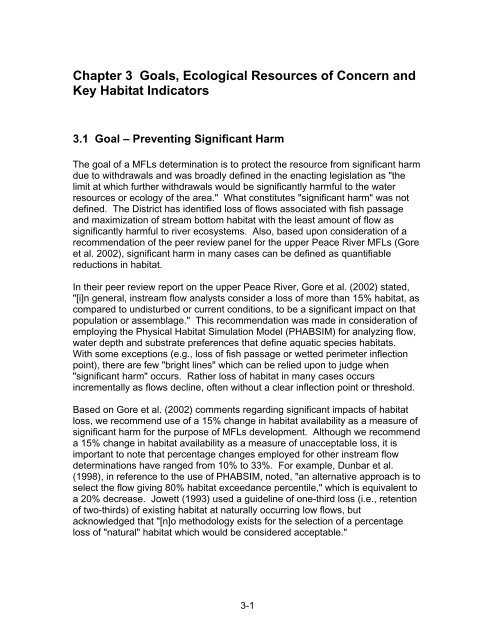Chapter 1 Minimum Flows and Levels - Southwest Florida Water ...
Chapter 1 Minimum Flows and Levels - Southwest Florida Water ...
Chapter 1 Minimum Flows and Levels - Southwest Florida Water ...
Create successful ePaper yourself
Turn your PDF publications into a flip-book with our unique Google optimized e-Paper software.
<strong>Chapter</strong> 3 Goals, Ecological Resources of Concern <strong>and</strong><br />
Key Habitat Indicators<br />
3.1 Goal – Preventing Significant Harm<br />
The goal of a MFLs determination is to protect the resource from significant harm<br />
due to withdrawals <strong>and</strong> was broadly defined in the enacting legislation as "the<br />
limit at which further withdrawals would be significantly harmful to the water<br />
resources or ecology of the area." What constitutes "significant harm" was not<br />
defined. The District has identified loss of flows associated with fish passage<br />
<strong>and</strong> maximization of stream bottom habitat with the least amount of flow as<br />
significantly harmful to river ecosystems. Also, based upon consideration of a<br />
recommendation of the peer review panel for the upper Peace River MFLs (Gore<br />
et al. 2002), significant harm in many cases can be defined as quantifiable<br />
reductions in habitat.<br />
In their peer review report on the upper Peace River, Gore et al. (2002) stated,<br />
"[i]n general, instream flow analysts consider a loss of more than 15% habitat, as<br />
compared to undisturbed or current conditions, to be a significant impact on that<br />
population or assemblage." This recommendation was made in consideration of<br />
employing the Physical Habitat Simulation Model (PHABSIM) for analyzing flow,<br />
water depth <strong>and</strong> substrate preferences that define aquatic species habitats.<br />
With some exceptions (e.g., loss of fish passage or wetted perimeter inflection<br />
point), there are few "bright lines" which can be relied upon to judge when<br />
"significant harm" occurs. Rather loss of habitat in many cases occurs<br />
incrementally as flows decline, often without a clear inflection point or threshold.<br />
Based on Gore et al. (2002) comments regarding significant impacts of habitat<br />
loss, we recommend use of a 15% change in habitat availability as a measure of<br />
significant harm for the purpose of MFLs development. Although we recommend<br />
a 15% change in habitat availability as a measure of unacceptable loss, it is<br />
important to note that percentage changes employed for other instream flow<br />
determinations have ranged from 10% to 33%. For example, Dunbar et al.<br />
(1998), in reference to the use of PHABSIM, noted, "an alternative approach is to<br />
select the flow giving 80% habitat exceedance percentile," which is equivalent to<br />
a 20% decrease. Jowett (1993) used a guideline of one-third loss (i.e., retention<br />
of two-thirds) of existing habitat at naturally occurring low flows, but<br />
acknowledged that "[n]o methodology exists for the selection of a percentage<br />
loss of "natural" habitat which would be considered acceptable."<br />
3-1
















